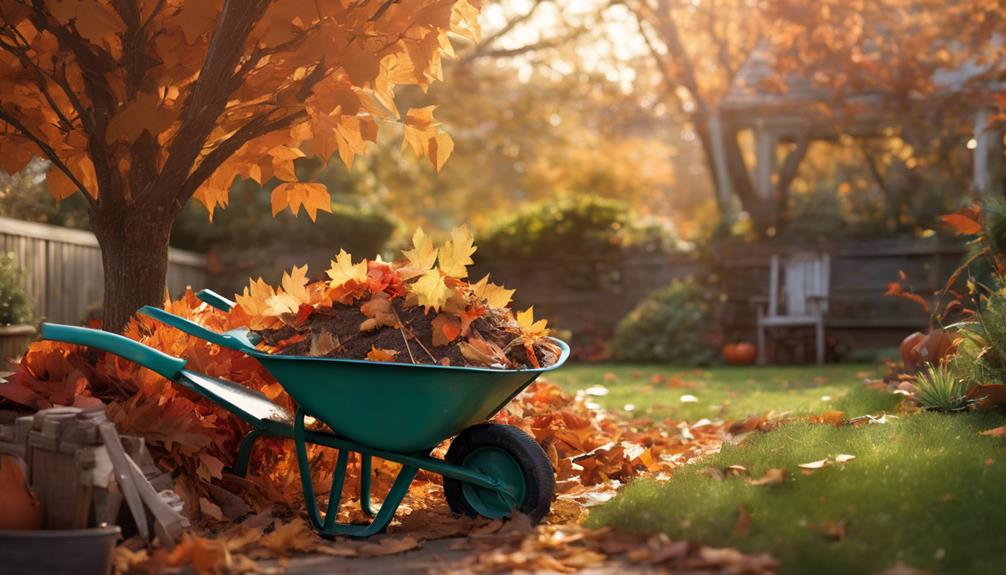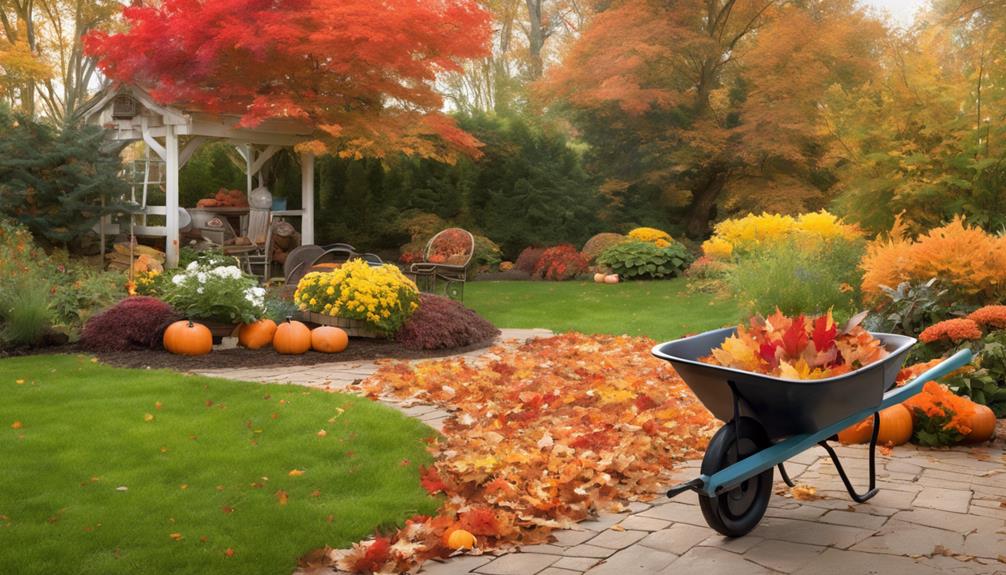
Three Tips for Seasonal Garden Pest Control
17 October 2024
Top Tips for Hardscape and Pathway Cleanup
18 October 2024To achieve a successful seasonal garden cleanup, focus on essential tasks.
Begin by clearing debris and dead plants to prevent diseases. Assess soil health and amend it with organic matter to optimise nutrient levels.
Properly prune perennials and shrubs for vigorous regrowth. Equip yourself with the appropriate tools, ensuring they are well-maintained for effectiveness.
Plan for the upcoming season by evaluating plant performance and layouts. Incorporating pest management strategies can further enhance garden health.
By following these guidelines, your garden will be prepared for productive growth. Discover more strategies for maximising your garden's potential.
Seasonal Garden Maintenance Essentials
To maintain a thriving garden, it is essential to have a comprehensive checklist of key tools tailored to the specific tasks at hand.
Furthermore, timing your clean-up activities appropriately ensures that plants receive the best care during seasonal shifts.
Understanding these maintenance necessities can significantly enhance the overall health and aesthetics of your garden.
Essential Tools Checklist
Effective seasonal garden maintenance hinges on the right set of tools, which can transform a challenging task into a manageable endeavour.
Start with vital hand tools: a sturdy trowel, secateurs, and a weeder to accurately address plant needs. A rake is fundamental for gathering debris, while a spade facilitates soil turnover and planting.
Invest in a quality garden hose with a spray nozzle for thorough watering. For larger areas, consider a leaf blower to expedite clean-up.
Furthermore, protective gear such as gloves and kneepads guarantees safety and comfort. A compost bin can also be invaluable for recycling organic waste.
With this essential toolkit, you will enhance your seasonal garden clean-up to a level of mastery, ensuring your garden flourishes.
Timing Your Cleanup
Timing your cleanup is crucial for maximising the health and beauty of your garden throughout the seasons.
Begin your autumn cleanup after the initial frost, as this signals that plants have entered dormancy. Removing dead foliage and debris not only improves aesthetics but also mitigates pest infestations and diseases.
In spring, timing is critical; wait until the soil is dry enough to work without compaction. Early spring cleanup allows for proper pruning, enabling new growth while preventing damage to tender buds.
Furthermore, seasonal changes are ideal for evaluating soil health, amending deficiencies, and preparing for planting.
Soil Health and Preparation
Maintaining soil health is fundamental for a thriving garden, and several strategies can improve its quality.
Implementing mulching techniques can greatly enhance moisture retention, while composting enriches the soil with important nutrients.
Furthermore, regular soil pH testing is key to understanding nutrient availability and ensuring ideal plant growth.
Mulching for Moisture Retention
Mulching plays a crucial role in enhancing soil health and moisture retention within garden ecosystems. By applying a layer of organic or inorganic materials to the soil surface, gardeners can significantly improve their cultivation practices.
Here are three key benefits of mulching:
- Moisture Conservation: Mulch reduces evaporation, allowing soil to maintain moisture for a longer period, which is critical during dry spells.
- Temperature Regulation: A mulch layer insulates the soil, keeping it cooler in summer and warmer in winter, thereby promoting ideal root development.
- Weed Suppression: By obstructing sunlight, mulch minimises weed growth, reducing competition for water and nutrients.
Implementing an effective mulching strategy fosters a robust garden environment, ensuring plants thrive even under challenging conditions while supporting overall soil health.
Composting for Nutrient Enrichment
Healthy soil is the foundation of a thriving garden, and composting serves as an effective method for enriching it with vital nutrients. By incorporating organic matter through composting, gardeners can improve soil structure, promote microbial activity, and enhance moisture retention.
Consider these key benefits of composting:
- Nutrient-Rich: Compost provides a balanced supply of essential nutrients, supporting plant growth.
- Soil Structure Improvement: It enhances soil aeration and drainage, which are important for root development.
- Sustainable Practice: Composting reduces waste and recycles kitchen scraps and garden debris, fostering environmental stewardship.
Engaging in composting not only nourishes your plants but also contributes to the long-term health of your garden ecosystem, ensuring it remains vibrant and productive.
Soil Ph Testing Importance
Understanding your garden's soil pH is fundamental for optimising plant health and growth.
Soil pH affects nutrient availability, microbial activity, and general soil structure. Testing your soil's pH ensures that you can make informed decisions regarding soil amendments and plant selection.
Here are three important reasons to prioritise soil pH testing:
- Nutrient Availability: Different plants thrive at specific pH levels, which influences nutrient absorption.
- Microbial Health: Healthy soil microbes are key for nutrient cycling and organic matter decomposition, both of which are pH-dependent.
- Plant Stress Reduction: Correct pH levels minimise plant stress, promoting resilience against pests and diseases.
Seasonal Tool Preparation Guide
As the gardening season shifts, proper preparation of your tools is crucial for optimal performance and safety.
Begin by gathering all necessary gardening implements, followed by thorough maintenance to ensure they are in peak condition.
Furthermore, understanding crop rotation strategies will enhance the effectiveness of your tools throughout the season.
Gather Your Gardening Tools
Before diving into your seasonal garden clean-up, it is vital to gather and prepare your gardening tools.
A well-organised toolkit not only improves efficiency but also ensures that you are ready for any task that arises during the clean-up process.
Here are three important items you should include:
- Pruning Shears: Essential for cutting back overgrown plants and shaping your garden.
- Rake: Necessary for collecting leaves and debris, promoting a tidy and healthy garden bed.
- Trowel: Ideal for digging, planting, and transferring soil as you rejuvenate your garden.
Tool Maintenance and Safety
Proper maintenance of gardening tools is essential for ensuring their longevity and effectiveness. Neglecting tool care can lead to diminished performance and safety hazards.
Here are three crucial maintenance tasks to prioritise:
- Cleaning: After each use, remove soil and debris. This prevents rust and promotes efficient operation.
- Sharpening: Regularly sharpen blades and cutting edges. Sharp tools require less force, reducing the risk of injury and improving precision.
- Lubricating: Apply oil to moving parts to prevent rust and ensure smooth operation. This extends the life of your tools.
Additionally, always inspect tools for damage before use.
Practising these maintenance strategies not only enhances performance but also fosters a safer gardening environment, allowing you to cultivate with confidence and mastery.
Crop Rotation Strategies
Implementing effective crop rotation strategies is crucial for maintaining soil health and maximising agricultural yields. By systematically varying crops in your garden, you can improve soil fertility, disrupt pest and disease cycles, and boost overall productivity.
Consider these key strategies:
- Diverse Crop Selection: Rotate among legumes, brassicas, and root vegetables to optimise nutrient uptake and replenish soil nitrogen.
- Seasonal Timing: Align planting schedules with seasonal changes to make the most of natural growth cycles and climatic conditions.
- Soil Health Monitoring: Regularly assess soil conditions to adapt your rotation plan, ensuring that you address specific nutrient deficiencies or pest pressures.
Increased Yield Potential
As gardeners, we all aspire to optimise the productivity of our plots, and understanding the factors that contribute to increased yield potential is essential. Key elements to evaluate include soil health, plant selection, and proper spacing. Implementing these strategies can greatly improve your harvest.
| Factor | Description |
|---|---|
| Soil Nutrients | Regularly amend with organic matter to enhance fertility. |
| Plant Variety | Choose high-yield varieties suited to your climate. |
| Spacing | Optimise plant density to maximise sunlight and airflow. |
| Water Management | Implement efficient irrigation systems to prevent drought stress. |
Pest Management Techniques
Effective pest management is crucial for maintaining a healthy garden ecosystem.
Techniques such as the release of beneficial insects, the application of organic pesticides, and the use of natural deterrent sprays can greatly reduce pest populations while promoting sustainable practices.
Beneficial Insect Release
Releasing beneficial insects is a highly effective strategy for managing garden pests while promoting a healthy ecosystem.
These natural predators can help maintain pest populations and improve biodiversity. To maximise the benefits of beneficial insect release, consider the following:
- Identify Target Pests: Understand which pests are prevalent in your garden to select appropriate beneficial insects.
- Choose the Right Insects: Options such as ladybirds, lacewings, and predatory wasps can effectively control different pest species.
- Timing and Conditions: Release beneficial insects during ideal weather conditions, typically in the early morning or late afternoon, to ensure their survival and effectiveness.
Organic Pesticide Application Methods
While managing garden pests organically can be challenging, the application of organic pesticides serves as a viable alternative to synthetic chemicals.
Mastering organic pesticide techniques is essential for effective pest management. Here are three key methods:
- Spray Application: Use a hand-held sprayer or backpack sprayer to evenly distribute the pesticide, ensuring thorough coverage on affected plants.
- Soil Drenching: This method involves applying the pesticide directly to the soil, targeting root pests and enhancing systemic absorption.
- Granular Application: Scatter granular organic pesticides around the base of plants to control pests that inhabit the soil or feed near the surface.
Natural Pest Deterrent Sprays
Natural pest deterrent sprays provide an additional layer of protection in the garden, complementing the use of organic pesticides.
These sprays utilise plant-based ingredients that repel unwanted insects while being safe for beneficial species.
To enhance their effectiveness, consider these key factors:
- Ingredient Selection: Choose sprays containing essential oils such as peppermint, neem, or citronella, renowned for their repellent properties.
- Application Timing: Apply sprays during the early morning or late afternoon when pest activity is at its peak, ensuring optimal coverage.
- Frequency of Use: Regularly reapply every 7-14 days, particularly after rainfall, to maintain a potent barrier against pests.
Weather-Related Planting Issues
Weather-related planting issues, particularly the threat of frost, can significantly affect garden vitality.
Implementing effective frost protection strategies and selecting frost-resistant plant varieties are essential for safeguarding your landscape.
Understanding your options in frost-resistant plant selection will further enhance your garden's resilience against unpredictable weather patterns.
Frost Protection Strategies
Frost can pose a significant threat to delicate plants, especially during the shifting seasons of spring and autumn.
Implementing effective frost protection strategies is crucial for safeguarding your garden. Consider the following methods:
- Cloches and Row Covers: Utilise transparent cloches or lightweight row covers to trap heat and shield plants from frost.
- Mulching: Apply a thick layer of organic mulch around the base of plants to insulate roots and retain soil warmth.
- Watering: Water plants thoroughly before a frost, as moist soil retains heat better than dry soil, providing vital warmth overnight.
Frost-Resistant Plant Selection
Selecting plants that can withstand frost is a prudent strategy for gardeners wishing to minimise weather-related challenges.
By incorporating frost-resistant varieties into your garden, you can ensure a more resilient landscape.
Consider these three key factors when choosing your plants:
- Hardiness Zone: Assess your local hardiness zone to select species that can thrive in your climate.
- Microclimates: Analyse your garden's microclimates, as areas with more sunlight or wind protection can support different frost-resistant plants.
- Soil Quality: Ensure well-draining soil to prevent root rot, which can compromise even the hardiest plants during cold spells.
Frost-Resistant Plant Varieties
A diverse array of frost-resistant plant varieties can significantly enhance the resilience of your garden against unpredictable cold spells.
Incorporating these plants not only enriches your landscape but also ensures longevity and vibrancy.
Consider these top choices:
- Hellebores: Known as the Christmas rose, these perennials bloom in winter and thrive in cold conditions.
- Pansies: Their vibrant blooms can withstand frost and provide colour during the cooler months.
- Sedum: This succulent variety is hardy and drought-resistant, making it an excellent choice for frost-prone areas.
Why Choose TKL Birmingham Gardener
Choosing TKL Birmingham Gardener ensures that your seasonal garden clean-up is managed by experienced professionals who understand the unique needs of local landscapes.
Our team possesses in-depth knowledge of Birmingham's climate, soil types, and plant species, ensuring your garden receives bespoke care. We utilise advanced techniques and sustainable practices to enhance the health and aesthetics of your outdoor space.
Furthermore, TKL Birmingham Gardener is committed to meticulous attention to detail, transforming your garden into a thriving ecosystem.
Our punctuality and reliability mean you can trust us to adhere to schedules and deliver exceptional results.
Common Gardening Queries Answered
Many homeowners have questions about maintaining their gardens, particularly regarding how to address specific challenges that arise throughout the seasons.
Common inquiries often focus on soil health, pest management, and plant selection suited to local climates. Understanding the importance of soil testing can empower gardeners to amend their soil effectively, ensuring optimal nutrient availability.
Furthermore, tackling pests requires a strategic approach, employing integrated pest management techniques to minimise chemical use while protecting beneficial organisms.
When selecting plants, it is essential to consider hardiness zones and native species that thrive in your region, promoting biodiversity and resilience.
Final Cleanup Checklist
Regularly conducting a final cleanup at the end of each gardening season is essential for maintaining the health and appearance of your garden.
A meticulous approach ensures that your garden remains vibrant and minimises pests and diseases.
Here's a final cleanup checklist to guide your efforts:
- Remove Debris: Clear fallen leaves, dead plants, and other organic matter to prevent fungal growth.
- Prune and Trim: Cut back perennials and shrubs to promote healthy regrowth in the next season.
- Soil Care: Amend the soil with compost or mulch to improve fertility and structure.




